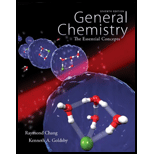
Concept explainers
(a)
Interpretation:
The energy change in the given process is whether ionization,
Concept Introduction:
Ionization energy is defined as the energy required to remove the valence electron of an atom when it is in gaseous state. In periodic table ionization energy of elements decreases down the column or group and increases across the row or period as it is inversely proportional to the atomic size.
Electron affinity is defined as the energy released when an electron is added (gained by an atom) to the atom in its gaseous state forming negative ion. In periodic table electron affinity of elements decreases down the column or group and increases across the row or period as it is inversely proportional to the atomic size.
Bond enthalpy is the energy required to break one mole of a bond or energy released when one mole of bond is formed between two certain atoms.
Standard enthalpy of formation is defined as the change in enthalpy under standard conditions when one mole of compound is formed from elements in pure state and standard conditions of pressure and temperature (
(b)
Interpretation:
The energy change in the given process is whether ionization, electron affinity, bond enthalpy or standard enthalpy of formation has to be ascertained.
Concept Introduction:
Ionization energy is defined as the energy required to remove the valence electron of an atom when it is in gaseous state. In periodic table ionization energy of elements decreases down the column or group and increases across the row or period as it is inversely proportional to the atomic size.
Electron affinity is defined as the energy released when an electron is added (gained by an atom) to the atom in its gaseous state forming negative ion. In periodic table electron affinity of elements decreases down the column or group and increases across the row or period as it is inversely proportional to the atomic size.
Bond enthalpy is the energy required to break one mole of a bond or energy released when one mole of bond is formed between two certain atoms.
Standard enthalpy of formation is defined as the change in enthalpy under standard conditions when one mole of compound is formed from elements in pure state and standard conditions of pressure and temperature (
(c)
Interpretation:
The energy change in the given process is whether ionization, electron affinity, bond enthalpy or standard enthalpy of formation has to be ascertained.
Concept Introduction:
Ionization energy is defined as the energy required to remove the valence electron of an atom when it is in gaseous state. In periodic table ionization energy of elements decreases down the column or group and increases across the row or period as it is inversely proportional to the atomic size.
Electron affinity is defined as the energy released when an electron is added (gained by an atom) to the atom in its gaseous state forming negative ion. In periodic table electron affinity of elements decreases down the column or group and increases across the row or period as it is inversely proportional to the atomic size.
Bond enthalpy is the energy required to break one mole of a bond or energy released when one mole of bond is formed between two certain atoms.
Standard enthalpy of formation is defined as the change in enthalpy under standard conditions when one mole of compound is formed from elements in pure state and standard conditions of pressure and temperature (
(d)
Interpretation:
The energy change in the given process is whether ionization, electron affinity, bond enthalpy or standard enthalpy of formation has to be ascertained.
Concept Introduction:
Ionization energy is defined as the energy required to remove the valence electron of an atom when it is in gaseous state. In periodic table ionization energy of elements decreases down the column or group and increases across the row or period as it is inversely proportional to the atomic size.
Electron affinity is defined as the energy released when an electron is added (gained by an atom) to the atom in its gaseous state forming negative ion. In periodic table electron affinity of elements decreases down the column or group and increases across the row or period as it is inversely proportional to the atomic size.
Bond enthalpy is the energy required to break one mole of a bond or energy released when one mole of bond is formed between two certain atoms.
Standard enthalpy of formation is defined as the change in enthalpy under standard conditions when one mole of compound is formed from elements in pure state and standard conditions of pressure and temperature (
Want to see the full answer?
Check out a sample textbook solution
Chapter 9 Solutions
Connect 2-Year Access Card for Chemistry: The Essential Concepts
 ChemistryChemistryISBN:9781305957404Author:Steven S. Zumdahl, Susan A. Zumdahl, Donald J. DeCostePublisher:Cengage Learning
ChemistryChemistryISBN:9781305957404Author:Steven S. Zumdahl, Susan A. Zumdahl, Donald J. DeCostePublisher:Cengage Learning ChemistryChemistryISBN:9781259911156Author:Raymond Chang Dr., Jason Overby ProfessorPublisher:McGraw-Hill Education
ChemistryChemistryISBN:9781259911156Author:Raymond Chang Dr., Jason Overby ProfessorPublisher:McGraw-Hill Education Principles of Instrumental AnalysisChemistryISBN:9781305577213Author:Douglas A. Skoog, F. James Holler, Stanley R. CrouchPublisher:Cengage Learning
Principles of Instrumental AnalysisChemistryISBN:9781305577213Author:Douglas A. Skoog, F. James Holler, Stanley R. CrouchPublisher:Cengage Learning Organic ChemistryChemistryISBN:9780078021558Author:Janice Gorzynski Smith Dr.Publisher:McGraw-Hill Education
Organic ChemistryChemistryISBN:9780078021558Author:Janice Gorzynski Smith Dr.Publisher:McGraw-Hill Education Chemistry: Principles and ReactionsChemistryISBN:9781305079373Author:William L. Masterton, Cecile N. HurleyPublisher:Cengage Learning
Chemistry: Principles and ReactionsChemistryISBN:9781305079373Author:William L. Masterton, Cecile N. HurleyPublisher:Cengage Learning Elementary Principles of Chemical Processes, Bind...ChemistryISBN:9781118431221Author:Richard M. Felder, Ronald W. Rousseau, Lisa G. BullardPublisher:WILEY
Elementary Principles of Chemical Processes, Bind...ChemistryISBN:9781118431221Author:Richard M. Felder, Ronald W. Rousseau, Lisa G. BullardPublisher:WILEY





